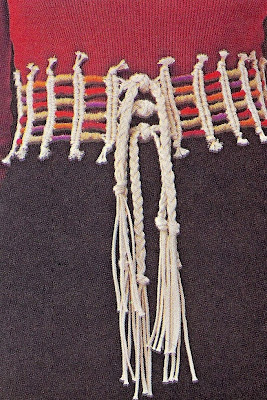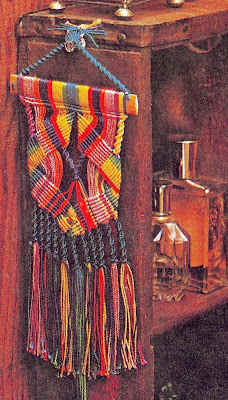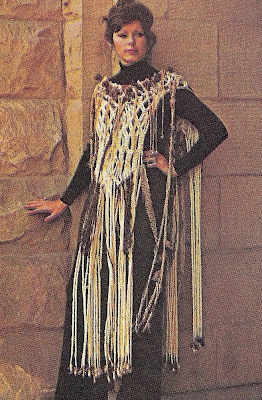Introduction
Macramé – the art of creative knotting – is one of the most ancient crafts known to man. The ancient Egyptians, Chinese, Maoris and Peruvians knew macramé. It was reasoned that primitive man must have had an early need to tie things together and probably progressed to complex weaving and decorative knotting such as macramé – although there are no surviving examples to confirm this conjecture. Whatever its origin, old style macramé lacework was extremely delicate in materials and effect and well established in the 13th Century in Arabia.
It was thought to have originated in Europe from the Middle East. The Arabic makrama means “protection, head covering”, while the Turkish migramah is a decoratively fringed napkin. It was the Turks who brought the craft to Spain and from there it spread throughout Europe, where it was taught in convents. It has said to have been introduced to England, by Mary, wife of William of Orange, and quickly became popular with women of the Court.
Queen Mary II, wife of William III, Prince of Orange. Painted by Willem Wissing (a Dutch-English court painter and draughtsman).
Macramé had also been a leisure-time occupation of sailors, who were used to tying knots in their work. Undoubtedly their travels around the world helped to spread the knowledge of the craft.
This depiction of sailors involved in doing macramé comes from the book of Kells, which is dated from the early Middle Ages.
In Victorian England, the technique found favor as one of the statutory “accomplishments” of gentlewomen and it was used for heavy and ornate decorations with which fashionable Victorians filled their homes. It gradually waned in Europe, but was revived in a more robust, equally attractive form in the late 19th and 20th Century in and around Turin and Genoa. It is now one of Italy’s more popular traditional crafts.
Macramé
Macramé is the knotting of threads or cords to produce decorative and functional art and craft items. Though it may appear complex, macramé is quite simple and easy to learn. There are a few basic knots and several variations to be remembered. Once these knots are learnt, you can design an endless variety of objects from jewelery to hanging planters to wall hangings to clothing.
Macramé materials should be flexible enough to be knotted but not so stretchy that they lose their shape. They may, therefore, include a wide range of cords.
The above macramé cords are suitable for a wide variety of projects. From left to right: Waxed linen, soutache, heavy rattail, four ply, Thai jute, heavy Thai jute, masons’ line, linen, macra-cord, navy cord, waxed nylon, cotton glow cord, macra-line, natural jute and sisal.
Basic macramé tools – scissors, flexible taper, T pins, knotting board (12" x 24”, 20" x 36” and 24" x 48”), rings and cords. Note: 2.5 cm = 1 inch.
The basic knots for a beginner are given below.
Mounting or holding the cord. The length is pinned horizontally across the board so that it is stretched taut with a pin through each knot.
Lark’s head (setting on) knot. The two loose ends are tucked through the loop and the knot is tightened around the holding cord.
Horizontal knotting. It is usual to secure the lark’s head knots with a row of horizontal knotting. (a) Horizontal double half stitches to the right.
Horizontal knotting. (b) Horizontal double half stitches to the left.
Diagonal knotting.
Square (flat) knots. Stage 1.
Square (flat) knots. Stage 2.
Complete square (flat) knots. Stage 3.
Spiral or sennits. These are formed by making only one stage of the square knot, either first or second stage, over and over again.
Overhand knot. This can be done using any number of cords but usually with a minimum of two.
Vertical double half stitches. The filler cords are vertical and the knots are formed by either one of the adjacent knotting cords or by a newly introduced cord.
Knotted chain. This is made by working simple knots around a filler cord, first one to the right, then one to the left so that the filler cord and the knotting cord constantly chain places.
Macramé Projects
The recipe for making the items below can be found in references [1-4]. To make this post brief only a description will be given of each item.
Bags
Shopping bag. Finished bag measures ca. 12 inches (30cm) wide (at the widest point), but it can be made to any desired width.
Sampler bag. Finished bag measures approximately 11.5 inches (28cm) square, excluding fringe.
Small bag. Length of bag (excluding fringe and handle) 9.75 inches (24.7 cm) height and 8.5 inches (21.3 cm) width.
Finished purse measures approximately 4.5 inches (11.3 cm) square.
Coverings for handbags.
Belts
Tie belt. The belt is intended as a loose-fitting tie belt, and can be made to any length to suit the size of the waist. The center pattern section should be equal to the size of the waist plus 4 inches (10 cm). Beaded tie at each end should equal approximately 9 inches (22.5 cm).
Oriental matted belt and head band.
Bracelet and Belt. Bracelet: Cotton twine, 3 oval polished wooden beads (25 x 14 mm) and nine small round wooden beads. Belt: cotton twine, metal ring (2.5 cm) in diameter and 8 oval polished wooden beads (25 x 14 mm) and 24 small round wooden beads. Note 1 inch = 25 mm.
Leather Thong Belt.
Multicolored belt.
Necklaces
Earthly found object necklace, macraméd with wax linen and leather.
Sweep of Hackle feathers frames 76 carats of smoked topaz quartz double half stitched together with wax linen.
Persian color.
Choker. Length from center back fastening round to center from drop is approximately 12 inches (30 cm); width at the sides of the choker (excluding beads) is approximately 2 inches (5 cm).
Pendant necklace.
Wax linen necklace.
Necklace.
Starburst Necklace.
Sea and Sand Necklace.
Berries and Beads Necklace.
Josephine knot necklace of wax linen displaying old Chinese coins.
Wall Hangings
Wall hanging. Measures approximately 22 inches long (excluding fringe) and 10 inches wide.
"Meteora" - Wall Hanging.
"Sea Life" - Wall Hanging.
"Allacciare" - Wall Hanging.
Detail of Wall Hanging.
Miniature Wall Hanging.
Multicolored Wall Hanging.
Tree Hanging.
Household Artefacts
Window shade. Made in jute yarn, the design allows the light to filter through. The open motif in the centre can be hung with a large shell, a bead or some other interesting object. The shade measures 75 cm (29.5 inches) wide by 91 cm (36 inches deep), including the fringe.
Oriental Bell Pulls.
Candle Sling.
Outdoor Plant Hanger.
Wall Sculpture.
Wall Sculpture.
Clothes
Man's Vest.
Child's Sweater.
Mexican Olé Rebozo.
Soft Female Vest.
Pocahontas Dress.
References:
[1] The Basic Book of Macramé and Tatting, Octopus Books, London (1973).
[2] A. Jeffs, W. Martensson and P. North, Creative Crafts Encyclopedia, Octopus Books Pty Ltd (London) 1984.
[3] C. E. Kicklighter and R. J. Baird, Crafts, The Goodheart-Willcox Company Inc. (South Holland) 1986.
[4] Macramé, Editors of Sunset Books, Lane Publishing Co., Menlo Park (1976).
Macramé – the art of creative knotting – is one of the most ancient crafts known to man. The ancient Egyptians, Chinese, Maoris and Peruvians knew macramé. It was reasoned that primitive man must have had an early need to tie things together and probably progressed to complex weaving and decorative knotting such as macramé – although there are no surviving examples to confirm this conjecture. Whatever its origin, old style macramé lacework was extremely delicate in materials and effect and well established in the 13th Century in Arabia.
It was thought to have originated in Europe from the Middle East. The Arabic makrama means “protection, head covering”, while the Turkish migramah is a decoratively fringed napkin. It was the Turks who brought the craft to Spain and from there it spread throughout Europe, where it was taught in convents. It has said to have been introduced to England, by Mary, wife of William of Orange, and quickly became popular with women of the Court.
Queen Mary II, wife of William III, Prince of Orange. Painted by Willem Wissing (a Dutch-English court painter and draughtsman).
Macramé had also been a leisure-time occupation of sailors, who were used to tying knots in their work. Undoubtedly their travels around the world helped to spread the knowledge of the craft.
This depiction of sailors involved in doing macramé comes from the book of Kells, which is dated from the early Middle Ages.
In Victorian England, the technique found favor as one of the statutory “accomplishments” of gentlewomen and it was used for heavy and ornate decorations with which fashionable Victorians filled their homes. It gradually waned in Europe, but was revived in a more robust, equally attractive form in the late 19th and 20th Century in and around Turin and Genoa. It is now one of Italy’s more popular traditional crafts.
Macramé
Macramé is the knotting of threads or cords to produce decorative and functional art and craft items. Though it may appear complex, macramé is quite simple and easy to learn. There are a few basic knots and several variations to be remembered. Once these knots are learnt, you can design an endless variety of objects from jewelery to hanging planters to wall hangings to clothing.
Macramé materials should be flexible enough to be knotted but not so stretchy that they lose their shape. They may, therefore, include a wide range of cords.
The above macramé cords are suitable for a wide variety of projects. From left to right: Waxed linen, soutache, heavy rattail, four ply, Thai jute, heavy Thai jute, masons’ line, linen, macra-cord, navy cord, waxed nylon, cotton glow cord, macra-line, natural jute and sisal.
Basic macramé tools – scissors, flexible taper, T pins, knotting board (12" x 24”, 20" x 36” and 24" x 48”), rings and cords. Note: 2.5 cm = 1 inch.
The basic knots for a beginner are given below.
Mounting or holding the cord. The length is pinned horizontally across the board so that it is stretched taut with a pin through each knot.
Lark’s head (setting on) knot. The two loose ends are tucked through the loop and the knot is tightened around the holding cord.
Horizontal knotting. It is usual to secure the lark’s head knots with a row of horizontal knotting. (a) Horizontal double half stitches to the right.
Horizontal knotting. (b) Horizontal double half stitches to the left.
Diagonal knotting.
Square (flat) knots. Stage 1.
Square (flat) knots. Stage 2.
Complete square (flat) knots. Stage 3.
Spiral or sennits. These are formed by making only one stage of the square knot, either first or second stage, over and over again.
Overhand knot. This can be done using any number of cords but usually with a minimum of two.
Vertical double half stitches. The filler cords are vertical and the knots are formed by either one of the adjacent knotting cords or by a newly introduced cord.
Knotted chain. This is made by working simple knots around a filler cord, first one to the right, then one to the left so that the filler cord and the knotting cord constantly chain places.
Macramé Projects
The recipe for making the items below can be found in references [1-4]. To make this post brief only a description will be given of each item.
Bags
Shopping bag. Finished bag measures ca. 12 inches (30cm) wide (at the widest point), but it can be made to any desired width.
Sampler bag. Finished bag measures approximately 11.5 inches (28cm) square, excluding fringe.
Small bag. Length of bag (excluding fringe and handle) 9.75 inches (24.7 cm) height and 8.5 inches (21.3 cm) width.
Finished purse measures approximately 4.5 inches (11.3 cm) square.
Coverings for handbags.
Belts
Tie belt. The belt is intended as a loose-fitting tie belt, and can be made to any length to suit the size of the waist. The center pattern section should be equal to the size of the waist plus 4 inches (10 cm). Beaded tie at each end should equal approximately 9 inches (22.5 cm).
Oriental matted belt and head band.
Bracelet and Belt. Bracelet: Cotton twine, 3 oval polished wooden beads (25 x 14 mm) and nine small round wooden beads. Belt: cotton twine, metal ring (2.5 cm) in diameter and 8 oval polished wooden beads (25 x 14 mm) and 24 small round wooden beads. Note 1 inch = 25 mm.
Leather Thong Belt.
Multicolored belt.
Necklaces
Earthly found object necklace, macraméd with wax linen and leather.
Sweep of Hackle feathers frames 76 carats of smoked topaz quartz double half stitched together with wax linen.
Persian color.
Choker. Length from center back fastening round to center from drop is approximately 12 inches (30 cm); width at the sides of the choker (excluding beads) is approximately 2 inches (5 cm).
Pendant necklace.
Wax linen necklace.
Necklace.
Starburst Necklace.
Sea and Sand Necklace.
Berries and Beads Necklace.
Josephine knot necklace of wax linen displaying old Chinese coins.
Wall Hangings
Wall hanging. Measures approximately 22 inches long (excluding fringe) and 10 inches wide.
"Meteora" - Wall Hanging.
"Sea Life" - Wall Hanging.
"Allacciare" - Wall Hanging.
Detail of Wall Hanging.
Miniature Wall Hanging.
Multicolored Wall Hanging.
Tree Hanging.
Household Artefacts
Window shade. Made in jute yarn, the design allows the light to filter through. The open motif in the centre can be hung with a large shell, a bead or some other interesting object. The shade measures 75 cm (29.5 inches) wide by 91 cm (36 inches deep), including the fringe.
Oriental Bell Pulls.
Candle Sling.
Outdoor Plant Hanger.
Wall Sculpture.
Wall Sculpture.
Clothes
Man's Vest.
Child's Sweater.
Mexican Olé Rebozo.
Soft Female Vest.
Pocahontas Dress.
References:
[1] The Basic Book of Macramé and Tatting, Octopus Books, London (1973).
[2] A. Jeffs, W. Martensson and P. North, Creative Crafts Encyclopedia, Octopus Books Pty Ltd (London) 1984.
[3] C. E. Kicklighter and R. J. Baird, Crafts, The Goodheart-Willcox Company Inc. (South Holland) 1986.
[4] Macramé, Editors of Sunset Books, Lane Publishing Co., Menlo Park (1976).

























































3 comments:
I want to lean how to make the oriental bell pulls, do you know where I can get instructions?
I am looking for instructions for the oriental bell pulls.
I will let you know if I come across information for oriental bell pulls instructions
Post a Comment